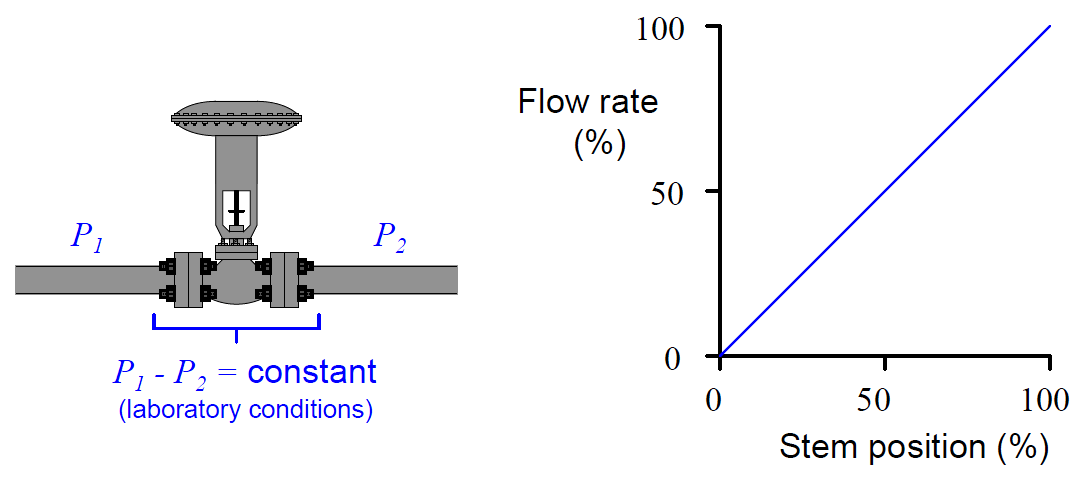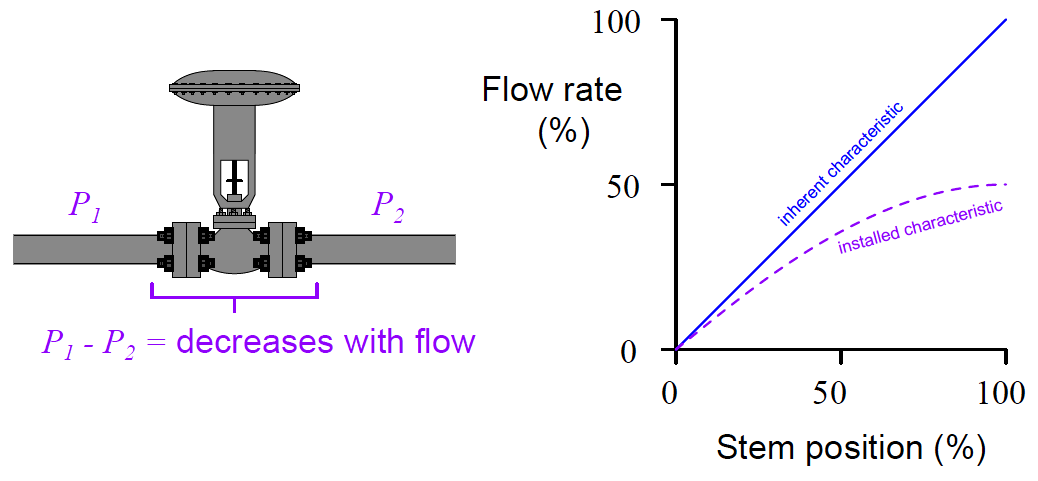What is inherent characteristic of a valve ?
The inherent characteristic of a valve is the characteristic published by the manufacturer, based on tests performed in a system where great care is taken to ensure that the pressure drop across the test valve is held constant at all valve openings and flow rates.
The inherent characteristic, therefore, represents the relationship between valve flow capacity and valve opening when there are no system effects involved
What is Installed characteristic of a valve ?
The installed characteristic is the plot of flow against opening of valve using actual pressure drops experienced in practice.
Due to the fact that in most applications the pressure drop increases as the flow rate drops, the installed characteristic will normally change from =% towards linear, and from linear towards quick opening.
Inherent vs Installed Control Valve Flow Characteristics
When control valves are tested in a laboratory setting, they are connected to a piping system providing a nearly constant pressure difference between upstream and downstream (P1 − P2 = constant).
With a fluid of constant density and a constant pressure drop across the valve, flow rate becomes directly proportional to the valve’s flow coefficient (Cv).
This is clear from an examination of the basic valve capacity equation, if we replace the pressure and specific gravity terms with a single constant k:

(If pressures and specific gravity are constant . . .)
Q = k.Cv
As discussed in an earlier article, the amount of “resistance” offered by a restriction of any kind to a turbulent fluid depends on the cross-sectional area of that restriction and also the proportion of fluid kinetic energy dissipated in turbulence.
If a control valve is designed such that the combined effect of these two parameters vary linearly with stem motion, the Cv of the valve will likewise be proportional to stem position.
That is to say, the Cv of a “linear” control valve will be approximately half its maximum rating with the stem position at 50%; approximately one-quarter its maximum rating with the stem position at 25%; and so on.
If such a valve is placed in a laboratory flow test piping system with constant differential pressure and constant fluid density, the relationship of flow rate to stem position will be linear.
With constant pressure drop, the flow rate through any valve is directly proportional to that valve’s Cv, and with a “linear” valve design the Cv (and therefore the flow rate as well) must be directly proportional to stem position:

However, most real-life valve installations do not provide the control valve with a constant pressure drop. Due to frictional pressure losses in piping and changes in supply/demand pressures that vary with flow rate, a typical control valve “sees” substantial changes in differential pressure as its controlled flow rate changes.
Generally speaking, the pressure drop available to the control valve decreases as flow rate increases.
The result of this pressure drop versus flow relationship is that the actual flow rate of the same valve installed in a real process will not linearly track valve stem position. Instead, it will “droop” as the valve is further opened.
This “drooping” graph is called the valve’s installed characteristic, in contrast to the inherent characteristic exhibited in the laboratory with constant pressure drop:

Each time the stem lifts up a bit more to open the valve trim further, flow increases, but not as much as at lower-opening positions. It is a situation of diminishing returns, where we still see increases in flow as the stem lifts up, but to a lesser and lesser degree.
I have found this concept of “installed characteristic” to be especially challenging for many engineers. In the interest of clarifying the concept, the next two subsections will present a pair of contrasting valve performance scenarios.
Dear Mr. S Bharadwaj Reddy,
Thank you very for your great series posts about Control Valve.
I was wondering if the Flow Coefficient (Cv or Kv) should be independent on operating conditions Pressure and Flow rate. In the other work, the values of Kv at each valve opening should be const no matter if the inherent condition occurs or not.
Look forward to hearing from you soon.
Best regards,
Nguyen Quang Khai,
Offshore Plant System Lab
Dept. of Naval Architecture & Ocean Engineering
Pusan National University
Cellphone: +82 10 3419 1803